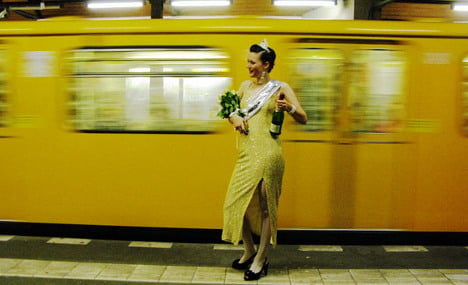Like a traditional pageant, the August 14 show will be divided into four segments: evening wear, swimsuit competition, talent performance and a question and answer session, sole organiser Mirabelle Jones told The Local.
“The pageant part is tongue-in-cheek, but the fashion is not,” the 26-year-old American said. “These are serious designers who are all well-established in Berlin and very unique, from costume designers to couture.”
The goal for contestant duos is to bring their chosen station to life, using details such as the appearance, materials, history and neighbourhood folk to inform their ideas.
Miss Zoologischer Garten’s getup, designed by artist Paradox Paul, will have live animals incorporated into the gown. Miss Warschauer Straße’s dress will be made of broken glass from Beck’s beer bottles. Miss Schlesisches Tor’s designs will be modelled by a drag queen.
Meanwhile each performer’s talents will be station-related, including live graffiti, opera and burlesque dancing.
“It’s about getting the public involved,” Jones said. “The models are performance artists and not just static people. And it’s a celebration of the city.”
Jones, a poet and performance artist hailing from San Francisco, has spent the last two years in Berlin, a city she says is “vibrant and supportive of giving artists space” to grow.
The Miss U-Bahn pageant is the first show with her newly founded production company and “mind hive” 3-2-1,000, which focuses on what she calls “future content.”
“I became frustrated that fashion, music, and style continues to harp on retro-isms,” she said, explaining that the subway pageant will be a Berlin first.
The idea came about through a different set of frustrations that followed a fruitless seven-hour visit to the Ausländerbehörde, or foreigners’ authority, where she left without a residence permit and with instructions to return again later.
Riding the U7 line home, Jones observed the many-coloured underground stations through her tears.
“And then I got to Richard Wagner Platz,” she said. “It’s hideous, but almost alive with pink, butter yellow and black tiles, and then pictures from ye olden days – it’s supposed to represents Wagner’s operas.”
Jones was so inspired by the garish sight that she spent the rest of the day riding U-Bahn lines, taking in the views of stations across the city.
Each Berlin U-Bahn station is different, she found, initially planning to photograph them for an exhibition, but ultimately deciding to invite designers and performers to breathe life into each stop with fashion instead.
Jones is not only organising the entire event, but participating herself as part of the design team for Miss Richard Wagner Platz, her original inspiration.
A spoken word artist Paula Varjack will emcee the event at Spreewaldplatz, after which the judges panel, comprising Berlin fashion industry professionals, will award the winner a crown and sceptre, in addition to a cash prize.
“It’s very Berlin,” she said explaining that many of the participants may not be German-born, but have been living in the city for a long time. “The idea is that we are all Berliners, we love the city and have a relationship with it.”
MISS UBAHN
August 14, 5 pm
Spreewaldplatz 8
After party at Kleine Reise



 Please whitelist us to continue reading.
Please whitelist us to continue reading.
Member comments